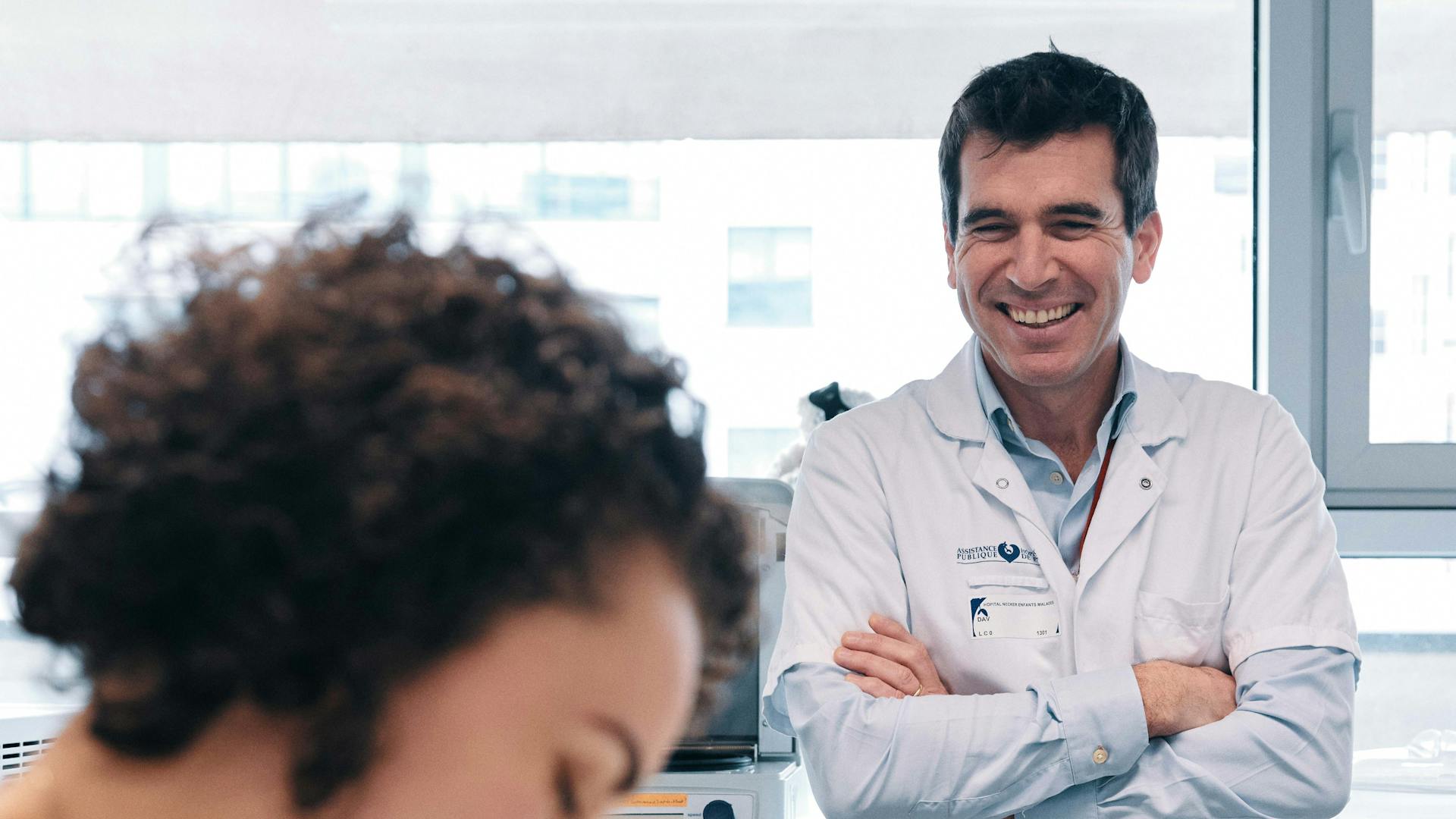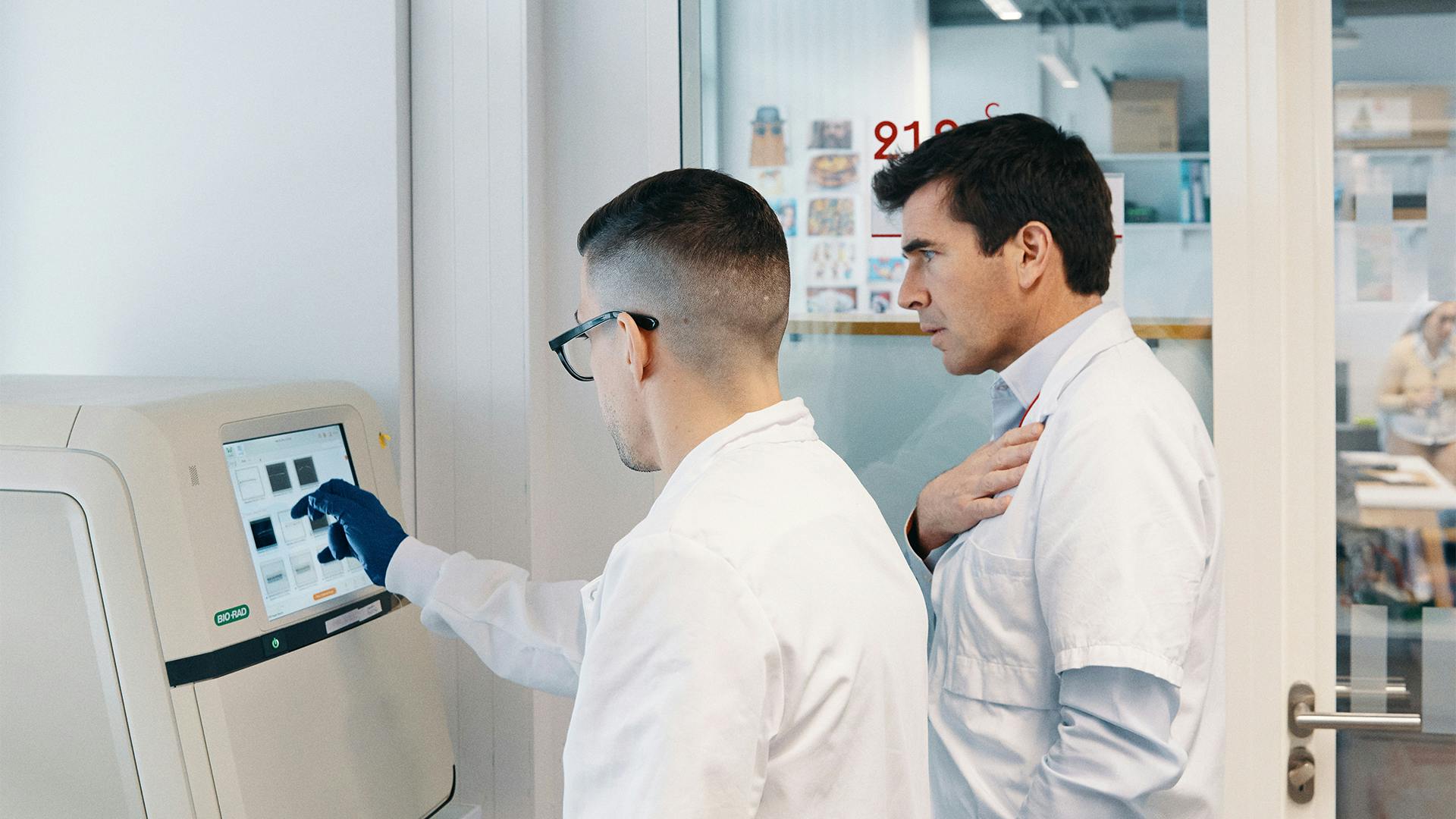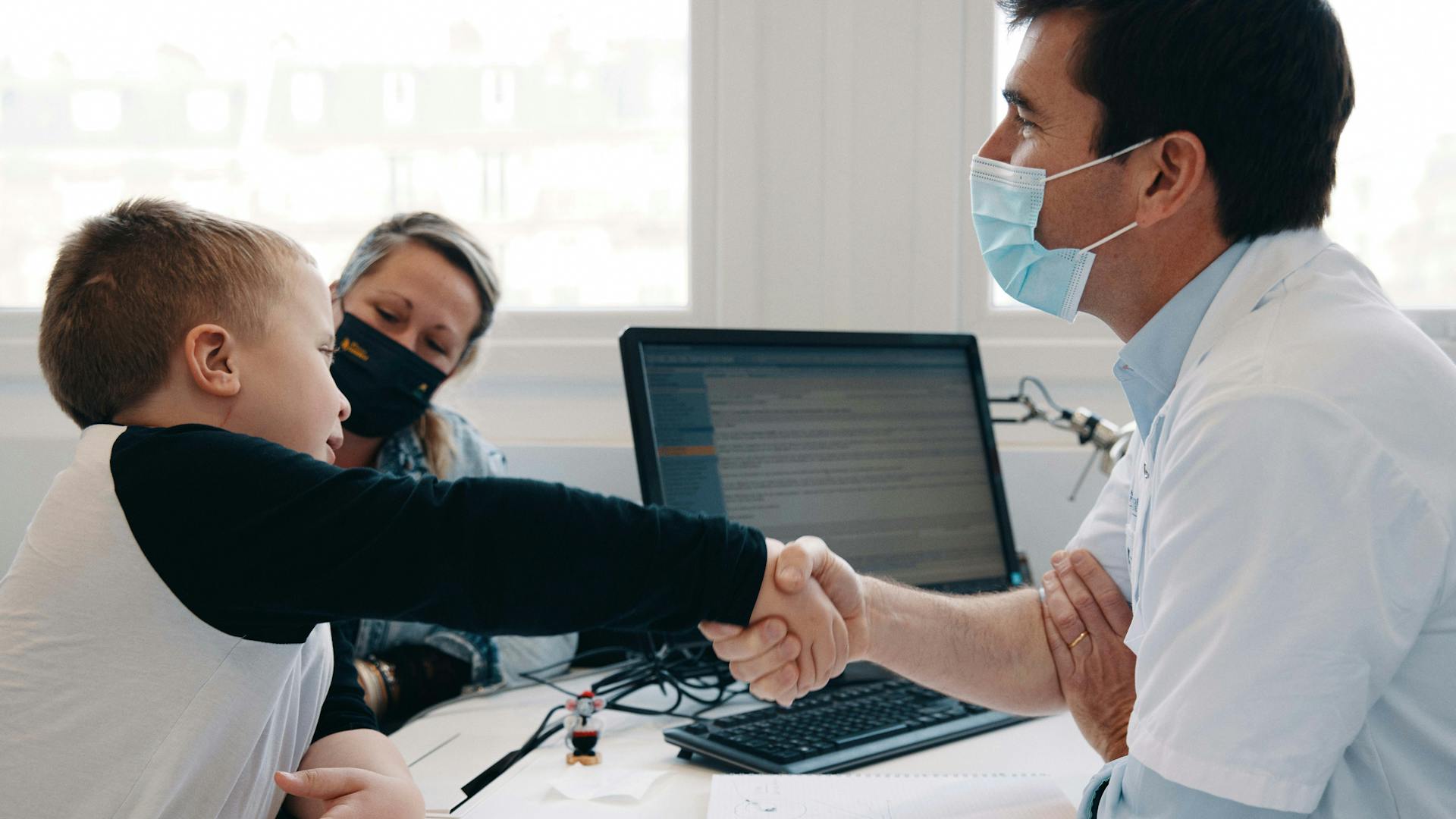
A life-changing encounter
Between the golden cupola of the Dome des Invalides and the towering Tour de Montparnasse lies one of the medical treasures of France’s capital – the Necker-Enfants Malades Hospital, which can trace its origins back to the 19th century. Among the many breakthroughs achieved here, Novartis contributed to one of the latest medical accomplishments through an access program.
Text by Goran Mijuk, photos by Laurids Jensen, videos by Nicolas Heitz, illustrations by Philip Bürli



Walking is second nature to Guillaume Canaud. Every day, the 45-year-old physician-scientist takes thousands of steps between his cabinet at the Necker Hospital and his lab in a nearby research and education center of the University of Paris.
The daily exercise not only keeps him fit but also helps him refocus his mind as he switches between bench and bedside. The short stroll also offers a welcome break in an otherwise hectic schedule that started to accelerate some seven years ago.
This was when Canaud, who initially specialized in kidney diseases, saw a patient who besides a kidney condition also suffered from a rare disease which affects only a dozen people out of a million.
“This encounter, which happened in 2015, was a game changer for me,” Canaud recalled, when we met him in Paris. “Until then, I was a nephrologist and did research in the kidney domain. But this opened up an entire new medical sphere for me.”


Guillaume Canaud in his lab ...
... discussing the latest results with researchers.
Pivoting research
After obtaining his medical degree in Montpellier and his research Ph.D. in Boston, Canaud set up a nephrology lab in Paris with three researchers in 2014. After meeting the patient, he focused his efforts on this rare disease, for which there was no meaningful treatment.
“I moved from the kidney field to this new area because this patient was extremely frail,” Canaud recalled. “He had a very severe condition, and back then we had no direct opportunity to treat this patient.”
This is the reality faced by most patients suffering from a rare disease. Experts estimate that there are more than 7000 rare conditions that affect some 400 million patients worldwide, who have few to no treatment options.
Although regulatory changes have helped pave the way for the development of more than 400 rare-disease treatments since the 1970s, the medical gap is still massive. And the biological understanding of many rare diseases is equally limited.
“Starting from this single patient, we tried to understand the genetic trigger for the disease and get a clearer understanding of the underlying biology,” Canaud explained. “This is how we learned about a Novartis compound.”
Experts estimate that there are more than 7000 rare conditions that affect some 400 million patients worldwide, who have few to no treatment options.
Although regulatory changes have helped pave the way for the development of more than 400 rare-disease treatments since the 1970s, the medical gap is still massive.
Compassionate Use
Novartis had been working on a treatment in another indication that targeted the same molecular pathway, which was malfunctioning in this rare-disease population. Since the compound was being tested in early clinical trials at the time, it was not available on the market.
To get hold of the molecule and test it, Canaud tapped into what is known as Compassionate Use regulation, which exists in France and many industrialized countries. Under this rule, doctors can ask companies for access to treatments that are either not on the market or are used in other indications to treat patients with life-threatening conditions.
“Starting from this patient, we created some in vivo and in vitro experiments to demonstrate that this drug compound could be efficient,” Canaud said. “And then, thanks to the good results that we obtained, we moved to the patient very quickly.”
The outcome was stunning. The patient’s condition improved, helping reduce pain, fatigue and other symptoms. “We were all very excited to see the effect,” Canaud said. “So we decided to go over our medical records at Necker to see if we had additional patients with that kind of rare condition.”
To Canaud’s and his team’s surprise, they found more than a dozen patients who suffered from this rare condition, which is triggered by a genetic mutation that causes the growth of benign tumors and can cause severe pain and inflammation in patients. Severe forms of the disease may lead to life-threatening complications.
Under the Compassionate Use program, Canaud again asked Novartis for access to the drug. And after obtaining the compound, he started to treat more patients with the severe and/or life-threatening condition that he had identified at Necker.
Canaud subsequently published the findings in 2018, which triggered massive interest in the medical community.
Managed access
“Following the readings of our paper, my life totally changed,” Canaud said. “I received thousands of e-mails from patients and physicians from all over the world, who wanted to know more about this medicine and to treat other patients with this condition.”
To help an increasing number of patients with the severe and/or life-threatening condition, Canaud started to collaborate more intensively with Novartis, which set up a global Managed Access Program to extend the treatment available under Compassionate Use in France to additional patients worldwide.
Under its Managed Access Programs, Novartis is making certain investigational or unapproved treatments available to eligible patients. Every year, Novartis receives around 10000 requests to provide some of its medicines and experimental compounds to patients in need.
The company recently conducted a major study, published in The Journal of the American Medical Association, which found that most requests are from industrialized countries. The study, which was led by Paul Aliu, who heads the company’s Managed Access Programs, also suggested that while more research is needed, Compassionate Use programs could help “translate into improved early access to novel lifesaving products for patients with unmet medical needs.”
Under its Managed Access Programs, Novartis is making certain investigational or unapproved treatments available to eligible patients.
Every year, Novartis receives around 10000 requests to provide some of its medicines and experimental compounds to patients in need.
Real-world evidence
For Novartis, improving access to healthcare is of strategic importance. The company was therefore ready to assist Canaud, said Oliver Jung, Global Program Head at Novartis, who led these activities with his team.
“For us, it was a transformative journey,” Jung said. “We were not only able to provide the compound as part of our global Managed Access Program, but we had the opportunity to learn how to use real-world data to support regulatory approval, thus making the compound available faster to patients with a severe or life-threatening rare disease.”
After setting up the program, which allowed doctors around the world to get access to the compound and benefit from Canaud’s findings, Novartis started to collect the patient data as part of its so-called real-world evidence efforts. Real-world evidence refers to medical data that are collected outside traditionally designed randomized trials.
Before embarking in the data collection, Novartis connected with healthcare regulators to discuss how to develop the compound into a regular medicine. “Through this procedure, we were able to learn how to deliver access to drugs faster by using real-world evidence while we were setting up a traditional clinical trial,” Jung said.
“Thanks to these efforts, Novartis was able to work with health authorities to get patients access to the drug significantly earlier,” Jung said, adding that such a procedure can help Novartis and other healthcare companies serve patient needs more efficiently.

Canaud’s work in the clinic usually happens in the morning, when he meets his patients for a private consultation.
Life-changing treatment
For many patients, the efforts of Canaud and Novartis have changed their outlook on life.
A mother of a seven-year-old boy, whom we met in Paris, told us that her son had already had multiple operations and had exhausted most of his medical options, when she heard of Canaud’s efforts.
“I wrote an e-mail,” she said, “with the hope to meet him in Paris. And not even two weeks later, we had our first appointment. Before, I had struggled for years to find a doctor who could really understand and help my son.”
This was three years ago. Back then, her son could neither walk nor communicate properly, as the disease had hampered his development. Thanks to the treatment, he has learned to walk for extensive stretches and has even started to talk.
An older patient we met said that, without the treatment, his quality of life would be much worse than it is today. “Due to the disease, which I had suffered from since childhood, I had repeated swelling and inflammation. The treatment now helps me to better control my life.”
Today, at age 42, he has decided to work as an independent illustrator after having been employed for most of his adult life. “Of course, part of my decision to become independent is linked to workplace changes in the aftermath of the pandemic. But the other reason is that I feel more confident today than just a few years ago.”
For many patients, the efforts of Canaud and Novartis have changed their outlook on life.
A mother of a seven-year-old boy, whom we met in Paris, told us that her son had already had multiple operations and had exhausted most of his medical options, when she heard of Canaud’s efforts.
This was three years ago. Back then, her son could neither walk nor communicate properly, as the disease had hampered his development. Thanks to the treatment, he has learned to walk for extensive stretches and has even started to talk.
Opening a new dimension
For the Necker Hospital, Canaud’s findings are the latest in a series of breakthroughs that started more than 200 years ago when René Laennec invented the stethoscope. Another major highlight came in 1953 with the first kidney transplant by Jean Hamburger.
Canaud is likely to win similar accolades, but his focus remains on helping patients. “This work has transformed my life,” Canaud explained. “As a physician, of course, I was already dedicated to my patients. But now there is a specific link with these patients. It has totally changed my view of the patients and my commitment to help them.”
The development of the treatment has also changed Canaud’s outlook on collaboration with the industry, patient groups and regulators. “Initially, we only wanted to understand what is causing the malformation in the first patient,” Canaud said. “But now, as our research group has grown substantially over the past few years, we are really focusing on how to help patients by developing new treatments.”
Canaud’s group, which today includes around 20 scientists and technicians, is currently working on understanding underlying deviations in some patients and is collaborating with partners across the healthcare spectrum to improve treatments.
“Ever since I have been a physician-scientist, I have always wanted to understand how things function,” Canaud said. “That I was able to participate in the development of a new treatment for patients is a dream come true.”
Likewise, for Novartis, the collaboration has proved full of valuable lessons and is opening up new dimensions.
“As a leading healthcare player with a strong commitment to access to healthcare, we have always been interested in providing our treatments to patients in need,” said Oliver Jung. “In our collaboration with Guillaume Canaud and the many other physicians who joined later, we were able to pave a new path and prove that a global Managed Access Program coupled with real-world evidence methods can be instrumental in making new treatments available to patients in need faster. It is an approach we want to continue wherever it makes sense.”



